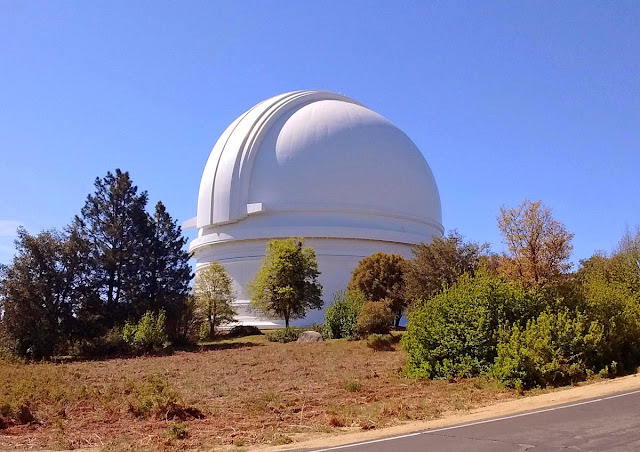In 2003 the Cedar Fire burned over 280,000 acres of San Diego County. Much of it was in the forested mountains. Nearly all the conifers (>95%) were lost in the Cuyamaca Mountains. In order to grow back they need at least 18 inches of rain annually. They haven't been getting that much in recent years--so conifers may be permanently gone in many places where they were found formerly. One area of forest that was spared in 2003 and again in 2007 fires was Palomar Mountain State Park and the nearby observatory.
 |
| Palomar Observatory |
I visited Palomar Observatory in April 2015 and wrote about it here.
In September 2016 I wrote a birding site guide to Palomar Mountain Sate Park.
Here are some common birds to know from the forests of Palomar Mountain.
 |
| Acorn Woodpecker. Palomar Mountain, California. July 13, 2014. Greg Gillson. |
This brash, noisy woodpecker is common in oak groves, and is especially common in the oak-pine forests surrounding Palomar Mountain. Birds spend their days placing acorns into holes they drill in the dead branches of their granary trees. That way they'll have food for winter. As the acorns dry, they shrink and become loose. So the birds move them to slightly smaller holes and wedge them in tightly so they will be more difficult for squirrels to remove. They are constantly adding, testing, and moving acorns. This bird was the inspiration for Woody Woodpecker! Similar San Diego birds: Nuttall's Woodpecker.
 |
| Band-tailed Pigeon. Julian, California. July 3, 2015. Greg Gillson. |
Here is another bird that feeds on acorns in the foothills and mountains. It also eats elderberries. Both of these are abundant at Palomar Mountain. I didn't know this until researching, but Palomar Mountain is evidently named for these birds (paloma means dove in Spanish). The deep cooing these birds make is often mistaken for owls, though pigeons do not coo at night. These birds also rely on mineral springs and fly every day to drink from them. Similar San Diego birds: Eurasian Collared-Dove, White-winged Dove, Mourning Dove, Domestic Pigeon.
 |
| Dark-eyed Junco. Palomar Mountain, California. July 13, 2014. Greg Gillson. |
Most people with backyard feeders in North America know this bird--often called "Snow Birds" by those who don't know the junco name. However, in San Diego it is more restricted to oak woodlands and higher mountains, generally above 1500 feet elevation (Unitt 2004). Various subspecies of "Oregon" Juncos with black-headed males (as depicted above) are most common. In winter, Gray-headed Juncos, Pink-sided Juncos, and Slate-colored Juncos are rare, more frequent in the mountains. Similar San Diego birds: None.
 |
| Mountain Chickadee. Palomar Mountain, California. July 13, 2014. Greg Gillson. |
This is the only California chickadee found south of Santa Barbara County. I was surprised to find Mountain Chickadees regularly in lowland towns in northern San Diego County. The San Diego County Bird Atlas found one pair breeding near Fallbrook (Unitt 2004). However, in recent years they seem regular throughout the year (albeit in very small numbers) in backyards in Vista, San Marcos, and Escondido. Here is eBird May and June records for past 10 years. Similar San Diego birds: Oak Titmouse (habitat, behavior, and husky "chick-a-dee" calls similar)
 |
| Steller's Jay. Cuyamaca Rancho State Park, California. 22 March, 2015. Greg Gillson. |
This black-headed jay with the sweeping crest is common in pine and oak woodlands at higher elevations. If you picnic at a mountain campground you are likely to be accosted by begging Steller's Jays. This bird has a name that drives certain precise people (a.k.a. the "spelling police"--who me?) crazy. The bird is named after Georg Wilhelm Steller from birds he collected and brought back on the Vitas Bering expedition from Russia to Alaska. Thus, it may be a stellar jay, but it's name is Steller's Jay. Similar San Diego birds: Western Scrub-Jay.
 |
| Yellow-rumped Warbler. Cuyamaca Rancho State Park, California. 22 March, 2015. Greg Gillson. |
This is perhaps the most abundant winter visitor to San Diego County. It is found from lowlands to higher mountains, September to May. It is an extremely rare breeder on a few peaks that reach above 5000 feet. Winter birds are paler and streaky showing only a hint of the breeding plumage. Eating insects in summer, they switch to fruit and berries (even poison oak berries!) in winter and are thus able to remain in more northerly climes than other warblers. Birds breeding in northeastern Alaska and east of the Rocky Mountains have white throats; Western birds have yellow throats and were formerly described as separate species--Myrtle and Audubon's Warblers, respectively. Similar San Diego birds: Townsend's Warbler.
Birds to know in San Diego: introduction
Next: Birds to Know in San Diego: Any City Park with a Pond

No comments:
Post a Comment
I really want to hear from you! I've changed settings (again) in order to try to make commenting easier without opening it up to spammers. Please note, however, that comments to posts older than 14 days will be moderated. Thank you.